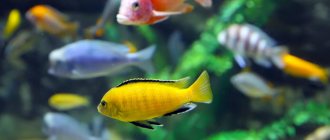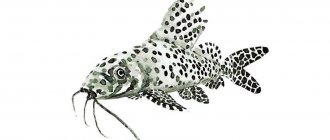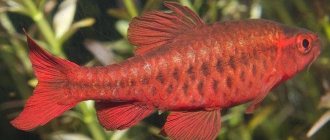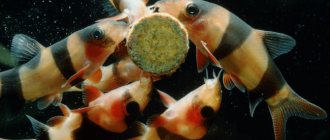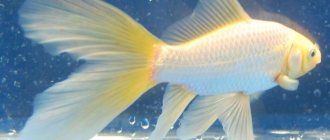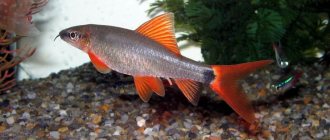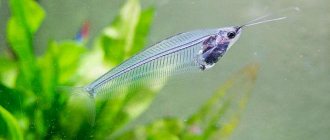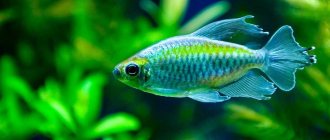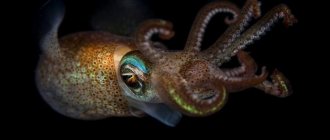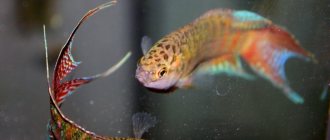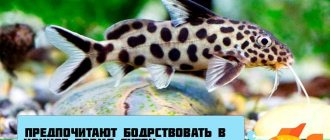Cichlids are one of the most common families of freshwater fish in home aquarium keeping. They gained popularity due to their extreme unpretentiousness (most representatives), bright colors and interesting both everyday and mating behavior.
Cichlids differ in the continents on which they live, in size, food preferences, living conditions, and methods of caring for offspring. All of them are united by innate aggressiveness, although in different species it is developed to varying degrees.
Most representatives of cichlids have a clearly developed territoriality, so delimiting the aquarium with decorations (stones, driftwood, grottoes, caves, plants - different for different species) often solves this problem.
Based on the size of the adults and the temperament of the species, a suitable aquarium volume is selected. For example, cichlids from Lake Malawi are recommended to be planted “densely” to reduce their level of aggression. And large American cichlids, on the contrary, are kept in pairs or alone in spacious containers.
A cichlid aquarium will never be boring! These fish are social and active, most of the time they “sort things out.”
We have selected the most popular and most commonly found cichlids in aquariums.
Parrot (Cichlasoma sp.)
The parrot is perhaps the most commonly found cichlid in home aquariums! This is a selectively bred fish, the ancestors of which live in the waters of America. Parrots are unpretentious and attractive! Their body is tall, barrel-shaped, with expressive eyes and a rather large mouth bordered by thick lips on the head. The coloring of parrots is varied: they can be plain (red, yellow, green and others), or they can have artificial patterns on the body (tattoos of various shapes and colors). Parrots grow up to 25 cm and can live about 10 years. These fish need spacious aquariums of 150-200 liters. Parrots can lay eggs, but they almost never produce offspring.
Contents
To ensure living conditions and make life healthy and long, it is necessary to find out what living conditions are required for these creatures to get along. Availability of an aquarium with a capacity of more than 200 liters. Accurate adherence to temperature conditions; cichlid aquarium fish are extremely sensitive to temperature changes. The ideal temperature would be 27–28 degrees Celsius, and the water should be clean and enriched with oxygen. Availability of a filter and water aeration system for the aquarium.
Once a week the water is partially changed. Each species living in a common aquarium must have its own shelter, so it is necessary to zone the aquarium with plants, stones, and other decorative elements. As well as the presence of caves, houses and other places where they can make shelters for weak cichlids and spend time. The lighting of the aquarium should not be too bright; moderate diffused light is sufficient. You can purchase cichlidariums, these are special ready-made aquariums for keeping a certain type of fish based on the requirements for care and maintenance, which can easily get along. After all, each variety of cichlids in an aquarium may have distinctive care requirements. Therefore, before buying fish, it is better to consult a specialist.
Aquarium decoration
Many species of cichlids are big fans of digging up soil. Because of this, many aquarists decide to completely abandon vegetation in a glass home for underwater pets. But you can find another way out - place floating plants in it, which cichlids cannot harm . A normalized amount of duckweed will decorate the tank and make it more attractive.
Experts recommend giving preference to plants with hard leaves, strong stems and a strong root system. These criteria must first be met by those plants that you decide to place in the ground.
For some species of cichlids, such as discus, apistogramma and microgeophagus, vegetation in the aquarium is considered a prerequisite. Greenery serves as a good shelter for them and makes them feel completely safe.
The glass tank in which cichlids live should not be overloaded with a large number of objects. Tanks should be designed carefully, taking into account all the characteristics of the fish being described. Pisces definitely need space, a sufficient amount of free space where they can swim calmly.
If you do decide to plant vegetation in an aquarium with cichlids, then it is better to place it in small groups . Plants can be used to divide the internal space in the tank. They are often planted along the back wall.
The cichlid can be supplemented with beautiful artificial caves, grottoes, snags, and pipe cuttings. All these components should not be placed above the middle level in a glass container. It is advisable to place them away from each other.
Caves and grottoes can be made from flat stones or coarse pebbles. The ideal solution would be large sinks.
Compatibility
Typically, cichlid fish are aggressive only during the breeding season. At this time, they establish their territory, which is strictly prohibited for outsiders to enter. Naturally, the living area of the neighbors will be somewhat reduced, which can cause inconvenience for the entire population of the aquarium, so it is advisable to keep cichlids in spacious aquariums.
Note: It is not wise to keep several male parrot cichlids in one tank. The aquarium can be quite large and spacious, but only one male will take the lead and will chase the rest of the males and force them to hide in the thickets of plants.
Angelfish and parrots, as well as other calm and small cichlid fish, are well suited for living together: swordtails, mollies, platies, gourami, zebrafish, catfish, cockroaches, corydoras and other peaceful species with similar temperature preferences.
Feeding
The wide variety of conditions in which cichlids live has led to the fact that all types of food can be found in this group of fish. There are carnivorous, herbivorous and omnivorous species. Therefore, when choosing food, it is necessary to take into account the natural origin of fish and know their natural diet.
Cichlids can be called predatory and feed on small fish, zooplankton, mollusks and crustaceans. This group includes some African cichlids, cichlids, and American cichlids. Food for such fish must be rich in protein, otherwise growth and development may be delayed.
Malawian cichlids of the Mbuna group are typical vegetarians. Their diet should consist of 60-70% plant foods. In nature, these fish have adapted to scraping algae from the surface of rocks. In this they are helped by sharp teeth, which can also serve as a formidable weapon in skirmishes over feeding territory.
Despite the predominance of one type of food, not a single herbivorous fish will refuse to eat meat. This is necessary to compensate for the lack of essential amino acids in the body. Predators also need periodic feeding with plant foods as a source of vitamins.
Very often, owners start feeding cichlids, especially large predators, from the table: fish scraps, ground beef and even cat food. Unfortunately, this often leads to disastrous results. Firstly, the quality of the water in the aquarium may deteriorate. Secondly, fish do not always have the necessary enzymes to digest and assimilate proteins from an atypical diet (in nature, cichlids do not eat cows). Thirdly, a large amount of protein for herbivorous species will sooner or later lead to disruption of the gastrointestinal tract in fish. Finally, it is extremely difficult to balance such food with all nutrients and vitamins.
Thus, when feeding cichlids, it is best to pay attention to high-quality dry food, which is created taking into account the nutritional characteristics of the fish and is completely balanced. Tetra offers a wide range of food for different types of cichlids:
- Tetra Malawi (flakes and granules) is a high quality food with a special algae mixture ideal for feeding all herbivorous cichlids. Ideal for Malawian cichlids of the “Mbuna” group: golden melanochromis, pseudotropheus Sokolov (Pindani), haplochromis cornflower, aulonocar Nyasa, etc.
- For dwarf cichlids such as Apistogramma or Pelvicachromis, small granules such as Tetra Cichlid Mini Granules are a good choice. They fit perfectly into the small mouth of the fish.
- Tetra Cichlid Color is a floating food in the form of balls with a concentrate of natural color enhancers. Provides vibrant color to all types of red, yellow and orange cichlids. It will be indispensable for keeping hummingbird cichlids, aulonocaras, and golden leopards.
- Tetra Cichlid Sticks are the basic stick food for all cichlid species. Floating granules stay on the surface of the water for a long time and quickly saturate large fish such as astronotus or acara.
- Tetra Cichlid XL Flakes are the main food in the form of large flakes for all types of cichlids. The flakes remain floating on the surface for a long time and are good for fish that bite off pieces of food slowly, such as angelfish.
- Tetra Cichlid Pro is an innovative food in the form of chips, manufactured using gentle low-temperature technology, which allows you to preserve even more nutrients and vitamins. It will be a good help when feeding active medium-sized cichlids: princesses of Burundi, black-striped cichlids.
It is recommended to feed the fish several times a day with such a portion of food that they have time to eat in a few minutes. Do not overfeed the fish. It is useful for large cichlids to have “fasting days” once a week. The more varied the feeding of the fish, the better their health will be.
Behavior
It is the interesting behavior of these fish that has earned them such popularity among aquarists. For this, they are forgiven for all the difficulties of keeping that often arise in people who have not previously kept cichlids. By nature, cichlid aquarium fish are territorial. One individual or pair occupies a certain part of the aquarium and guards it. In large aquariums this does not create acute problems, other fish simply stay in the opposite part of the home pond, but in a small aquarium they have nowhere to go - and the matter can even end in the killing of a weaker individual.
What is typical for cichlids is that they often drive away only representatives of their own species, not paying attention to other fish. Only during the breeding season can aggression be directed at everyone. Even just watching fish swimming in an aquarium, you can notice their unusual behavior. In search of food, they can turn over objects, and some large species are even able to recognize their owner. This is clearly noticeable when feeding - they are ready to take food directly from his hands, while they will not take food from another person’s hands.
Health and life expectancy
Cichlids are fish that have a strong immune system. But this does not mean that they cannot get sick. If these underwater pets are kept incorrectly, they may end up contracting some disease. The causes of infectious, bacterial or chemical diseases can be:
- poor quality food;
- insufficient amount of feed consumed;
- water parameters that do not meet all requirements;
- fish poisoning with nitrates;
- stressful conditions.
Various infections can enter the aquarium as follows:
- with new vegetation, which is purchased either for design or for the general arrangement of the tank;
- through any type of soil;
- with live food;
- with new fish.
Cichlids most often suffer from such diseases.
- Hexamitosis. It manifests itself as enlarged pores in the head and lateral line. At the same time, the fish do not eat and suffer from exhaustion. This disease is treated only with metronidazole. If the stage is advanced, then the pets may die.
- Ichthyophthiriasis (“semolina”). If this disease occurs, a white coating appears on the body of the fish. It can only be treated with specialized means. The use of quinine hydrochloride is allowed.
- American Bloat . This disease manifests itself in the lethargy of the fish, as well as in their loss of appetite. The body of the individuals is inflated, the eyes bulge. This disease continues for 3 days, after which the fish die. Most often, American bloat occurs with people from Lake Malawi. The disease can only be treated with antibiotics.
- Saprolegniosis . With this disease, you can notice that growths similar to cotton wool have appeared on the body of the cichlids. This disease can only be treated with medications containing phenoxyethanol.
Many health problems for these underwater pets can be avoided if you provide them with proper care. It is important to monitor the condition of the fish in the aquarium, maintain optimal water parameters and provide only high-quality food. Only if these conditions are met can you expect cichlids to live a long time and not get sick.
The lifespan of different individuals is also different. In their natural habitat, cichlids can live 20-25 years, but in an aquarium their lifespan is significantly reduced. Rare individuals can live more than ten years. Of course, a lot depends on the conditions in which underwater pets live.
If you keep them correctly, they can live for a very long time without suffering from disease. If it is not possible to provide cichlids with proper care, they will not live a very long life.
Diseases
Cichlid fish are quite strong, but improper maintenance can lead to diseases. Even in a reasonably stocked aquarium with clean water and complete quarantine control, an outbreak of diseases cannot be avoided, the cause of which may be poor nutrition and non-compliance with the temperature regime (in this case, hypothermia).
The most common disease is ichthyophthyriosis (fish louse). Accompanied by compression of the fins and scratching of the fish on the ground. The body and fins are covered with a white coating in the form of small grains (semolina). The causative agent of the disease is an equiciliated ciliate parasitizing on the body of fish. Parasitic ciliates can be present in almost any aquarium, but they usually affect fish with a weak immune system.
Another common disease caused by improper fish keeping can be saprolegniosis. A fungus appears on the affected area, which resembles a stuck piece of cotton wool. All sick fish must urgently undergo treatment until complete recovery. You can learn how to cure sick fish from the publication “Treatment of aquarium fish with bicillin.”
How to distinguish a female from a male?
Many people are interested in how to distinguish a female cichlid from a male. If individuals of different sexes have pronounced distinctive features regarding body structure and color, then it will not be difficult to determine whether the animal in front of you is a female or a male. If the fish are monomorphic species, then a thorough examination will have to be carried out to determine their gender.
This should only be done with wet hands. You will need to carefully remove the fish from the aquarium and turn it belly up. This area of the pet's body will need to be carefully examined. Between the anal fin and the opening there is such a part as the genital papilla. It is through this hole that during the spawning period, females release eggs, and males release seed.
In females this hole is always large. When determining the sex of individuals in this way, certain difficulties may arise, especially if we are talking about species that lay eggs in the substrate.
In certain situations, differences in gender can be identified by paying attention to pigmentation, which occurs in the area of the genital opening. In males, the papilla usually protrudes slightly. If you run your finger over this area, this feature can be noticed.
Many aquarists often rely only on their size when determining the sex of fish. In most cases, male cichlids are larger than females and it is not difficult to understand their gender.
In addition, differences in fins can be seen in most species. In males they are pointed, and in females they are rounded.
Reproduction
Spawning in cichlids can occur at any time of the year, but it is preferable that it be spring or summer, since in ordinary reservoirs you can catch live dust or cyclops. If the eggs are removed from the producers, then spawning can occur with an interval of 15 days, and if the eggs and fry are left, the interval can reach two months.
Fertility varies considerably among each species of cichlid. For some, it can be 100 fry, since the parent carries the eggs and fry in the mouth, and for those who spawn on stone or plants, the number of offspring is measured in the thousands.
Most species are bred simply; it is enough to raise the water temperature to 26–32 degrees. The composition of the water does not matter for many fish, although some species require soft water. When choosing neighbors for your pets, you need to take into account not only who the cichlids live with, but also the temperature range, the size of the fish, their aggressiveness, and nutrition. Most cichlids spend their youth in schools. With the onset of puberty, they divide into pairs.
In a large aquarium with plenty of hiding places, cichlids will disappear into the corners and victims can be avoided. Malawian cichlids can be kept in schools if they are provided with some kind of reef. For Tanganyika tropheus, shelters are strictly contraindicated. And keeping small fish that live in schools together with most cichlids is simply impossible! Cichlids are, first of all, predators that feed on any fish smaller than themselves.
AKARA MARONI
ACARA BLUE-SPOTTED
Angelfish (Pterophyllum scalare)
The angelfish is a popular and recognizable fish among aquarists, native to the waters of America. Angelfish have a highly flattened, high triangular body with long, showy fins, the pectoral fins of which have thinned and taken on the appearance of graceful threads. The color of the fish is varied: silver, gold, black, tricolor, striped or spotted. Angelfish grow about 15-20 cm and live for about 5 years.
An aquarium of 80 liters or more is suitable for these fish. Angelfish are quite unpretentious and relatively peaceful, suitable for a community aquarium with active, friendly neighbors. These fish are spawning fish and their reproduction in an aquarium is not difficult.
Starter feed
The smallest plankton is good as a starter food: rotifers, slipper ciliates, nauplis Daphnia moinus and artemia. It is best if these feeds are added in full, since “live dust” has a higher nutritional value.
If this is not possible, you should definitely give the fry crustaceans moin or brine shrimp. It is also necessary to ensure that the fry always have sufficient food. For more information about various foods, see the “Fish Food” category.
Notes: angelfish and discus fry can be fed with a special skin secretion located on the body of their parents. It should also be noted that trying to raise fry on dry food recommended by the industry is a futile exercise.
Labidochromis caeruleus var. "Yellow")
3. Labidochromis cerulius yellow - an unpretentious, bright inhabitant of the African Lake Malawi. Labidochromis has an elongated, slightly flattened body of a bright yellow color. The fins are bordered by a black stripe (except for the anal fin of females, which is not colored). The fish is very unpretentious and is perfect for beginner aquarists! Labidochromis grows about 10 cm and lives for about 4-5 years. This cichlid needs an aquarium of at least 100 liters. It is recommended to keep labidochromis in a “harem”, where there will be one male and several females. When kept in pairs, the male shows aggression and can offend or even kill the female.
Reproduction of Labidochromis yellow is very interesting! The female carries the fertilized eggs in her mouth and releases the already grown fry into the world, capable of swimming and feeding independently.
Care
Among cichlids there are relatively unpretentious and capricious aquarium fish. General rules for caring for cichlids:
- Change a third of the water once a week.
- Cleaning the soil from food debris and waste.
- Monitoring the condition of water and fish.
- High-quality and periodic feeding.
Water parameters differ for each species. There are ready-made cichlids on sale, equipped specifically for the type of fish you like.
Feeding
Fish are omnivores, the main part of the diet contains animal food.
Each species requires different food. Food for cichlids is:
- tubifex;
- daphnia;
- bloodworm;
- special feed;
- grated beef or pork heart;
- zucchini and cucumbers;
- spirulina;
- vegetable food in granules.
Blue dolphin (Cyrtocara moorii)
The blue dolphin is a favorite cichlid of many aquarists! The homeland of the blue dolphin is African Lake Malawi. The fish got its name for its resemblance to a dolphin. She has an elongated, slightly flattened laterally, slightly “humpbacked” body. In males, a fat “pad” grows on the head. The color of the fish is blue, sometimes with dark spots on the body. Dolphins grow up to 25 cm and live about 5 years. Dolphins are quite unpretentious and are suitable for beginner aquarists. An aquarium of 150 liters or more is desirable for them. Blue dolphins, compared to other cichlids, are peaceful, but territorial. It is better to keep them as a “harem”. Reproduction in dolphins, like other Malawian cichlids, easily occurs in a community aquarium. The female carries the eggs in her mouth, releasing independent fry - mini-copies of their parents.
Peculiarities of behavior of cichlids
Owners are captivated by the ability of some cichlids, mostly peaceful varieties, to remember their owner and recognize him. The fish can eat from his hand, but they do not show such friendliness and trust towards strangers. Representatives of these breeds are true family men; while still teenagers, they independently form pairs and walk, fin to fin, throughout their lives.
Cichlids are caring parents; they tirelessly watch the eggs, fan them with their fins and do not allow other inhabitants to approach them. Their joint care also extends to the fry. Fish love to rummage in the ground, and large specimens easily uproot vegetation and turn over large cobblestones. This must be taken into account when arranging a home for such inhabitants.
Pelvicachromis kribensis (Pelvicachromis pulcher)
Pelvicachromis kribensis is a small, bright, relatively peaceful, unpretentious cichlid native to the waters of Africa. Pelvicachromis are often found in community aquariums with small, calm fish. The suitable volume for them is from 50 liters. Pelvicachromis has an elongated body, slightly flattened laterally. The color of the fish attracts attention: on a gray background there is a dark horizontal stripe separating the light back and crimson belly. The dorsal and caudal fins have a bright eye-shaped pattern. Cribensis grow up to 8-10 cm and live for about 3-4 years.
These small fish easily reproduce in home aquariums, carefully caring for their offspring.
Conditions in the aquarium
Most African cichlids can be kept in a glass aquarium. They feed on algae, live food, and plant foods. You can create a semblance of a natural biotope by installing the semblance of rocks or rock caves in the reservoir. You should be careful when choosing soil - fish can dig it up or eat it if a piece of stone fits in their mouth. Plants are dug up, so plant potted hard-leaved species.
African cichlids require a lot of space to swim; install a large water tank with a capacity of 100-250 liters for a couple of fish. It is necessary to ensure good aeration and filtration of water, constant renewal of 30% with fresh water. Sometimes gravel and filter plates are moved, deteriorating the quality of the latter. The temperature in the aquarium should be maintained at 24-27o C.
It is important to monitor the acidity and alkalinity levels of the water. In all lakes in Africa, the water is different, so keeping each species requires special living conditions. Malawi has a pH of 7.7 to 8.7, Lake Tanganyika can have a pH of 9.3. The average range for African cichlids is pH 8.5, although they can survive in a neutral pH of 7.0, or even an acidic pH of 6.0. But low pH levels make fish susceptible to diseases, loss of color, and they stop reproducing.
Almost all species of cichlids from Africa are predators: they eat insect larvae, worms and fish. They can be fed live foods, frozen and cooked foods, seaweed, flakes and kibble. Some species are supplemented with carotene so that the scales are saturated with pigment. Herbivorous cichlids prefer plant foods rich in fiber: spirulina, salads, cereals, moss, duckweed.
Turquoise acara (Aequidens rivulatus)
Turquoise acara is a spectacular, powerful fish. Found naturally in American waters. Akara has a strong body with a pointed head. In males, by the time they reach sexual maturity, a fat “cushion” appears in the forehead area. The fish are elegantly colored: neon sparkles are scattered on the gray body and fins, the dorsal and caudal fins are bordered by a bright red stripe. Males grow larger than females, their size is about 20 cm, and they live for about 10 years. These fish need spacious aquariums of 150-200 liters.
Acaras easily reproduce in home aquariums, taking responsible care of the fry.
Varieties of cichlids
The cichlid family, despite their ubiquity, is usually divided into three large classes:
- South American - prefer soft water;
- African - love habitats with medium and high rigidity;
- Asian is the smallest class.
They include many species that differ somewhat in shape, size and behavior.
South American cichlids
Of these, the following varieties are especially popular.
Akary
These fish are small to medium sized cichlids. Quite peaceful ones are known among cancers, for example, the bluish-spotted one, and, conversely, even overly hostile species (turquoise).
Spotted Acara is found in the natural environment in calm waters of Panama and Colombia. At the beginning of the 20th century, this fish was brought to Europe and Russia by professional aquarists.
In artificial reservoirs it grows up to 5-7 cm, in nature it is much larger (about 15 cm).
The flattened tall body has a rounded shape, the grayish color of the skin is practically invisible under the greenish-golden scales. There are large dark marks and several vertical stripes on the sides. The gills are covered with an intricate blue pattern. The dorsal fin has a pink border in males, and a white border in females.
These fairly peaceful fish can be safely kept with other species.
Nannakar anomalies
The natural habitat of this species is the small reservoirs of Guiana. Introduced to Europe and Russia in the mid-20th century.
The fish are small - the size of females rarely reaches 3 cm, males are larger - up to 8 cm. Males are painted in turquoise tones with a scattering of dark marks, and a blue pattern is visible on the gills. The fins on the back have a green-blue tint, the belly fins are lemon and green, and the fins on the chest are transparent.
Females are not so bright, yellow in color with dark stripes along the sides. They behave quite calmly in the aquarium, but during the spawning period they become simply uncontrollable, even attacking other cichlids. At this time, they should be placed in a special spawning tank with abundant greenery.
Apistograms
These South American cichlids form a very large species that includes various subspecies. The most popular Apistograms are Ramizer, Kakadu, Two-Stripe, Panda, Hongslo.
Ramizer
They live naturally in the reservoirs of Venezuela. European and Russian aquarists began propagating them in an artificial environment in the 60s of the last century. They belong to the dwarf cichlid breeds; a rare individual reaches a size of 5 cm.
A tall, flat body of a yellowish color with a greenish or purple tint, with the same spots on the sides. There is a bright dark mark on the stomach, and two vertical stripes of the same color on the head between the large eyes. Males are larger than the brighter females, whose abdomen is usually purple-scarlet.
This species is absolutely non-aggressive and can get along with any aquarium inhabitants.
Cockatoo
Sometimes they grow up to 7 cm. They have a bright color, dominated by red, orange and gold tones. The dorsal fin resembles a fancy mottled scallop. These fish are quite angry.
Altispinosa or Bolivian butterflies
The most unpretentious representatives of this species, very bright and colorful, compatible with other fish. One of the few subspecies of cichlids that can be practiced by a novice aquarist.
Two-way or Biteniates
Small (up to 7 cm) and very active fish, beautifully colored with a characteristic dark stripe along the sides. Males are larger and brighter than females. Usually the main background is yellow, and the fins have a blue tint. It lives naturally in the rivers of Peru, Bolivia, and Brazil. Omnivorous and unpretentious in maintenance.
Panda
A very beautiful and small (up to 8 cm) fish that lives in the basin of two rivers in Peru - the Ucayali and Yavari. The color is yellow throughout the body and fins with dark markings, often in the form of vertical stripes near the head and a bluish tint. Carnivorous, but unpretentious in care.
Hongslo
Small, predatory and very bright fish. In nature, they live in the reservoirs of Colombia and Venezuela. Females are about 4 cm, males - 6 cm. They are brighter and more powerful, the color is dominated by reddish-yellow and orange tones. The fins are high-standing, sharp along the edge. In nature, they usually eat bottom invertebrates, but in an aquarium they are omnivorous and quite calm when there is an abundance of food. Monogamous, it is better to keep them as a pair or a small harem.
Cichlazomas
They have elongated slender bodies, sometimes reaching a length of 15-17 cm. There are many subspecies of them - Black-striped, Flamingo, Meeks, Festums, Peaceful, Yellow. All of them are distinguished by the presence of bright stripes or spots on the body.
Black-striped cichlazomas live in small lakes in Guatemala. In Europe and Russia, they began to successfully select this species in the 60s of the 20th century.
The body is rather gray in color with multiple (up to 9) black stripes arranged vertically, often because of this they are called Zebras. Females are slightly smaller than males with a more contrasting pattern and an orange belly. They are quite unpretentious and calm, but prefer large bodies of water with abundant vegetation.
Angelfish
Perhaps this is the most common variety of cichlids; they appeared in European aquariums already in 1909. In nature, they are numerous in the slow and wide rivers of South America.
They have a characteristic large body shape, resembling a crescent, a modified triangular shape, with long and voluminous fins. The native color - white with black stripes - is now rare in aquariums; there are many brightly colored breeds obtained through breeding. They differ in color, various body shapes and fins. Very peaceful and unpretentious inhabitants of reservoirs, they are loved by both beginners and professionals.
Discus
These fish are rightfully considered one of the most expensive and even elite. It is very difficult to maintain them so that you can admire the aquarium for hours. They are capricious both in terms of food and living conditions. In addition, they are very unstable to stress.
Its natural habitat is the calm waters of the Amazon. They appeared in Europe in the 30s of the last century, and the first experience of successful artificial breeding dates back to the 60s.
They have a large, almost round, flattened body (up to 20-25 cm). The color of natural species is bright brown with vertical dark stripes (there are 9 of them) and a greenish tint. Selected species of different colors - red, yellow, pink, white, blue.
These are peaceful fish, but for successful keeping it is better not to add other species to them.
The most famous breeds of discus are Heckel, Pigeon Blood, Leopard, Green, Cobalt, Marlboro, Blue Diamond, Snakeskin, San Mera, Red Melon, Red Card.
Astronotuses
Large cichlid species (up to 25 cm), living in nature most often in the waters of the Amazon. In the aquarium hobby, their widespread use began only in the 50-60s of the last century.
The main tone of the slightly elongated body is usually grayish-gray, but it can also have a yellow tint. The fairly large scales are scattered with golden markings in the form of spots and lines. Selection has made it possible to develop various color variations, but black and white and orange are more common.
Astronotuses are capable of digging up the entire soil, displacing the scenery. You cannot house peaceful fish with them, only similar predators.
Geophagus altifronsa
They have elongated massive bodies up to 20-22 cm. They live in the natural environment mostly in the Rio Negro River basin, they love lowlands and muddy floodplains, but with clean water.
Color ranges from yellow-orange to bluish. Large head with elongated lips. Sexual dimorphism is practically not developed; male and female individuals are very difficult to distinguish.
Peaceful and unpretentious inhabitants, they prefer to live in a flock of 5-8 individuals. Suitable for beginner aquarists.
Cichlids of Africa
This group is also diverse.
Handsome chromis
These small cichlids were introduced to Europe and Russia at the beginning of the 20th century. The maximum body size of aquarium species is 12 cm. The usual color is brown-red, and the spawning period becomes bright scarlet with iridescent greenish spots.
Keep only separately from other fish.
Celmatochromis pulchera
In nature, they live in tropical waters of West Africa. They appeared in European countries in the middle of the last century.
They have a variegated color with a greenish-golden background, a black back and a longitudinal graphite stripe on the sides. The plumage is dotted with dark markings, and on the belly there is a scarlet spot, better expressed in females.
Moderately hostile species, can be kept with fish of similar character.
Labidochromis yellow
Endemic to the African Lake Malawi, its description appeared in 1958.
The main color is bright golden with thin black edging on the fins.
Some varieties can show restrained aggression, but it is best kept only in species aquariums.
Haplochromis venustus
These cichlids are also an endemic species of Lake Malawi.
In captivity they grow to 25 cm or more. They have a golden-olive color with light markings throughout the body. This pattern is more contrasting in females; there are blue dots on the gills and fins.
Very smart hunters, attacking prey from bottom sludge, having previously buried themselves in it. You should not house them with other fish.
Melanochromis auratos
Another representative of Malawian hunters. Auratos have very pronounced sexual dimorphism - males are rather black with a white stripe on the sides, females are light in color with a graphite line along the entire body. Aggressive, kept only in cichlids.
Melanochromus aureus
These South African cichlids are large, beautiful predators. They are painted in golden tones, contrasting with the graphite fins.
Blue dolphins
The body shape of this underwater inhabitant of African lakes really resembles a dolphin. The color is light with a silvery-bluish tint. Peaceful and friendly fish, unpretentious in maintenance.
Red Devil
Cichlazomas labiatum are distinguished by a very exotic appearance and bright coloring, undemanding conditions of detention, and high endurance. But they weren’t called devils for nothing; they are extremely quarrelsome.
They are an endemic species of the tectonic lakes of Nicaragua and Managua, united by the underground Tipitapa River. A very large species, some individuals reach a length of 35 cm. Males are larger than females and have a pronounced occipital growth. The color of the scales ranges from soft lemon to bright orange.
Suitable only for keeping in a species aquarium.
Princess of Burundi
Cyclida Fairy is named after the name of the area where it was first discovered on the coast of the lake.
The most popular fish of Lake Tanganyika. Quite calm, if the size of the artificial reservoir is large, it is able to get along with other fish. It is better to keep 2-3 females with one male.
They are distinguished by their small size (up to 9 cm), weak sexual differences between males and females, gray-yellow colors, high fins with a bluish tint along the edges.
Dimidochromis
A very bright and beautiful predator, whose color is dominated by orange and blue tones. The head is large with powerful jaws.
It is endemic to Lake Malawi. In a large species aquarium it can get along with other large aggressive fish. It is difficult to keep at home, since the size of the smallest individual exceeds 25 cm.
The body is large but flat, it is the most flattened cichlid of Malawi. Males are metallic blue with bright orange fins, females and juveniles are rather simply silver.
Zebra Mbuna
One of the most hostile fish in Lake Malawi. Suitable for keeping in a species aquarium only.
"Mbuna" means "cliff dwellers", which describes the favorite habitats of this species.
A small fish (7-9 cm) has a large convex head and high-standing fins, pointed at the edges. There are a variety of colors - charcoal white, orange, blue-black, but the most common are blue and light blue tones with vertical stripes of the same color, but more saturated.
Queen of Tanganyika
The zebra lobed cyphotilapia or Frontosa is endemic to East Africa's Lake Tanganyika. It usually settles at very great depths (up to 70 m) along the rocky coastline. This is an insidious predator that, in a species aquarium, if there is sufficient food available, behaves quite peacefully.
A strong body up to 25 cm long has a large head with a characteristic growth on the forehead; it is more pronounced in males. Otherwise, sexual dimorphism is not developed. The main background is light, it is crossed out by wide dark stripes, making the fish really look like zebras. The sharp fins are colored in blue and bluish tones.
Asian cichlid species
There are only two naturally occurring species of cichlids thought to be found in the Asian region, but there are several others that overlap with the South American ones, such as the Oscars.
Spotted etroplus
Inhabitants of fresh and brackish waters of Sri Lanka and India.
Small fish, the maximum size of which rarely reaches 9 cm. Sexual dimorphism is weakly expressed, but males are slightly larger and brighter. They are quite peaceful and do not like to dig up the soil. Some aggression is shown during the period of caring for the fry.
The juveniles are very beautiful, the head is large with such large eyes that they seem to occupy its entire area. The main color is deep brown, and the chest is bright orange.
Green etroplus
Also common in water bodies of India and Sri Lanka, where they grow to almost half a meter in length.
In an aquarium, at 10-12 cm they already reach sexual maturity, growing to a maximum of 30 cm. They have a greenish color of scales and fins.
They are quite calm and peaceful, but they eat all aquatic plants.
Oscars
A very popular aquarium fish, which includes many subspecies with different fin shapes and scale colors.
They are found in nature in South and even North America, but an Asian species that lives in the reservoirs of Singapore is also known.
This is a fairly large fish, up to 35 cm long. The dark background color is colored with bright red spots. The high fins are black. This coloring is characteristic of natural species; breeding species are distinguished by a wide variety of colors.
After the Gulf War, many natural species of Asian cichlids were on the verge of extinction, so African tilapia are now introduced into reservoirs.
Multiple aquarium varieties of Asian cichlids have been bred based on natural isomorphs - Israeli Tilapia, Nile, Mango, Redberry, Ironocyclagordonsis, Green Chromide.
Haplochromis cornflower (Xiphophorus hellerii var.)
Haplochromis cornflower, or cornflower, as aquarists affectionately call it, is a bright, showy fish native to Lake Malawi. Haplochromis has a swift, elongated body with a narrow head. The color of the males is incredible: neon blue. Females and juveniles are much more modestly colored; they are gray, sometimes with stripes. Fish grow up to 20 cm and live 5-6 years.
Cornflowers are territorial; it is better to keep them in a harem or alone. The volume is suitable for them from 150-200 liters. Haplochromis always attracts the eye and serves as a decoration for the aquarium!
Cornflower haplochromis reproduce like other cichlids from Malawi: females carry eggs in their mouths.
Apistogramma ramirezi (Microgeophagus ramirezi)
Apistogramma ramirezi or apistogramma butterfly. A small and relatively peaceful cichlid native to the waters of America. This charming fish has gained the love of aquarists thanks to its good disposition, relatively small size and bright appearance. Ramirezi has an elongated, slightly flattened body. The first rays of the dorsal fin are longer than the others and are colored black, which creates a “tuft” effect. The body and fins are light, with scattered neon sparkles, and there are black markings on the back and head. Ramirezi grow up to 8 cm and live 3-4 years.
These cichlids, unlike most cichlids, get along well in community aquariums with peaceful, active fish. The suitable volume for them is from 50 liters. Apistogramma ramirezi can live in pairs and small flocks.
Apistogramma are capable of breeding in community aquariums. They are spawning fish that tenderly care for their offspring.
History of the species
Cichlids are a large family of ray-finned fish belonging to the order Perciformes. There are about 3 thousand different species in the world with body sizes ranging from dwarfs, barely reaching 2.5 cm, to meter-long individuals.
Some varieties are commercial, for example, tilapia, others are widespread in the aquarium hobby - Oscars, angelfish, discus.
Despite the fact that aquarists’ serious fascination with these beautiful inhabitants of the underwater world began not very long ago, African cichlid tilapia were first bred in artificial reservoirs in Ancient Egypt and Assyria many thousands of years ago.
Pseudotropheus zebra
Pseudotropheus zebra – a classic of the cichlid aquarium! The birthplace of fish is Lake Malawi. Zebras have an elongated, slightly rounded body with an elongated muzzle, on which there is a mouth with thick lips. The color of zebra pseudotropheus is varied: red, white, blue, spotted. The fish grow about 12 cm and live about 4-5 years.
Pseudotropheus are cocky and territorial; an aquarium of 150 liters or more with a large number of various hiding places is suitable for them. They should be kept as a “harem” to disperse aggression.
Zebra pseudotrophaeus, like other representatives of Malawian cichlids, carry eggs in their mouths.
Cichlids compatibility with other fish
Before getting fish of this breed, you should study the issue of Cichlid compatibility with other inhabitants of the aquarium. It is better to keep them separately, as they have a difficult character and can be aggressive.
Acara, Discus, and Angelfish have the most peaceful disposition. Cichlids get along well with Swordtails, Mellinesia, Gouramis, Danios, and catfish. These breeds live their own lives and do not offend other inhabitants of the aquarium.
Frontosa or Queen of Tanganyika (Cyphotilapia frontosa)
The frontosa or queen of Tanganyika is a powerful, spectacular fish native to Lake Tanganyika in Africa. Frontosa has a strong build; males have a fatty growth “cushion” on their head, giving the fish a menacing and majestic appearance. The color is blue-gray with dark vertical stripes. There are also morphs with pink and copper stripes. Frontoses grow up to 30 cm and live up to 20 years.
These fish need spacious aquariums of 300 liters or more. From the neighbors of frontoses, proportionate, non-aggressive fish can be suitable.
Reproduction at home is possible. The female carries the eggs in her mouth, releasing the already grown fry into the world.
What to feed cichlids
It is important to feed this breed of fish correctly. First of all, you should study what type of food is suitable for a given species, carnivorous, herbivorous or omnivorous. You cannot feed Cichlids only with dry food; the fish need live food.
Herbivorous species happily eat chopped lettuce, spinach, and dandelion; they will not refuse vegetables: cucumber, zucchini, carrots.
Predators need live food, that is, protein food: live bloodworms, cortera, chopped squid, fish, grated beef heart or liver. Omnivorous species consume 30% protein foods, 70% plant foods.
What to feed the fry
The fry that have just emerged from the eggs are fed with ciliates, daphnia, sedge; when they grow up, they are fed with daphnia, live crushed bloodworms, and ready-made food.
Astronotus ocellatus
Astronotus is a large, unpretentious cichlid native to the reservoirs of America. Astronotus have a powerful body, a pointed muzzle ending in a large mouth. The coloring of the fish is interesting and contrasting: there are red-orange spots on a dark background, sometimes merging into a solid pattern. There are also albino forms, in which the main color is milky white. Fish grow up to 30 cm and live about 8 years.
Young individuals can be kept in a small flock in an aquarium of 300 liters or more, adults - alone or in a formed pair. Astronotuses are beautiful, leisurely and graceful. They are able to decorate any aquarium with proportionate, calm fish. Reproduction of astronotuses occurs without problems in a general aquarium. These fish are spawn-laying fish that take good care of their offspring.
Discus (Symphysodon aequifasciatus)
Discus is a royal cichlid! So named for its grace, stature and incredible beauty. However, their demandingness and capriciousness does not allow beginners to keep discus, although, of course, this is the favorite fish of many.
The homeland of discus fish is the Amazon River, America. Today, a large number of color variations of these fish have been bred. Discus fish have a flat, tall body. The color of these fish is varied: blue, red, white, yellow, dark blue, plain, spotted, striped, etc. They grow about 20 cm and live 5-7 years.
You can't take your eyes off the discus aquarium! A special feature of keeping these fish is the high water temperature (+28..+30 degrees), so they should be kept in a species aquarium. For discus, a volume of 200 liters or more is suitable.
Discus spawners. They are caring parents, feeding their offspring at first with mucus from their bodies, the so-called “milk”.
How to avoid diseases
When buying cichlid fish, you need to know what this species is. About preferences in: nutrition, compatibility with other fish, temperature, as well as water hardness and acidity. If you have a rare and expensive specimen, for example, discus fish that love perfectly clean water, then it is better to keep such fish in a separate aquarium.
As we already know, most diseases are directly related to the immune system, which in turn is influenced by quality nutrition. The conclusion is this: if cichlid fish do not receive live food for a long time, which actually contains the essential amino acids necessary for the body, the health of those fish that are fed at least occasionally with live food will be significantly lower.
Notes: it should be noted that we are not talking about free feeding here, but only about feeding. I feed my fish with Daphnia moina. I feed little by little: in the morning at lunch and in the evening. The benefits of such feeding are obvious: the fish never show signs of dystrophy, they quickly grow in height, are always vigorous and cheerful, and their fins are clean and straightened.
I use Daphnia moinea to feed fry and recently purchased fish that are still in quarantine. Live food acts like a calming pill on new fish. Daphnia relieves stress because hardly any fish can resist moina. You can order Daphnia moina for home breeding on the “Food for Daphnia fish” page.
Handsome chromis (Hemichromis bimaculatus)
The beautiful Chromis is an “old” fish, but still popular among aquarists, originally from Africa. Chromis is unpretentious, great for beginners. The “handsome one” received its name for its incredibly bright red color with neon sparkles, which is especially pronounced during the spawning period. Chromis grow up to 15 cm and live for about 5 years.
These are quite aggressive and territorial fish, the suitable volume for them is from 80 liters.
Chromis spawn without any problems in a common aquarium, and at the same time they become even more aggressive towards their neighbors.
Diseases: symptoms and treatment
With proper care and good feeding, Cichlids rarely get sick; they are naturally endowed with good health. Changes in living conditions and stressful situations can weaken their natural immunity and lead to illness. Hypothermia, the presence of chlorine, excessive water hardness, and poor nutrition have a negative impact on the health of fish.
Most often they suffer from ichthyophthoriosis, caused by a parasitic ciliate. At the same time, the fins can dry out and become deformed, the fish scratches itself on objects and becomes restless. The treatment is simple: place the fish in salted water (10 g per liter of water) for a few minutes, repeat if necessary. It is important to treat all the inhabitants of the aquarium and then refresh the water.
Sometimes the Saprolegniosis fungus appears, looking like a piece of cotton wool or a clot of foam. In this case, a course of treatment with bicellin is necessary.
Fish will remain healthy for many years if you care for them properly!
Aulonocara sp.
Aulonokara is another representative of the cichlids of Lake Malawi. These fish have won the love of aquarists due to their unpretentiousness and variety of colors. Aulonocaras have a swift, slightly laterally flattened body with a sharp head on which rather large eyes are located. The color can be very diverse, depending on the type of aulonocara: neon yellow, red, blue, pink, plain or combined, striped or spotted. Moreover, such colors are found in males; females and juveniles are painted in modest gray colors. Fish grow up to 15 cm and live for about 5 years.
Aulonocar, like most Malawian cichlids, should be kept on hold to distribute aggression. An aquarium for these fish is suitable from 150-200 liters, equipped with a large number of various shelters.
Aulonocara females carry their offspring in their mouths.
Good neighbors
Before populating an artificial reservoir with cichlids, you need to familiarize yourself with the characteristics of this species. The character of fish is complex; not all species can coexist with them without danger.
Most aquarists are confident that cichlids get along only with representatives of three species:
- astronotuses;
- botia;
- acne.
Eels are able to resist ray-finned animals, so the pets will simply divide the territory so as not to intersect.
But catfish can also become good neighbors for cichlids. Cichlids prefer the upper and middle layers of the reservoir and catfish swimming in the bottom layer do not disturb them.
The compatibility chart applies to all cichlids.

